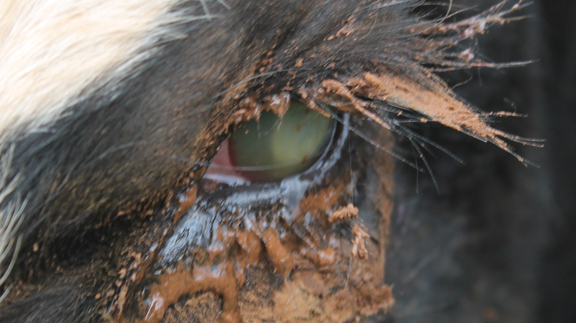Farm & Ranch
Infectious Bovine Keratoconjunctivitis (IBK)—Pink eye

By Jessica Crabtree with Dr. Jered Harlan
Aside from foot rot, infectious bovine keratoconjunctivitis, pink eye, is the next prevalent problem in cattle. Younger cattle seem to be more susceptible because older cattle have built protective antibodies on the eye surface as a result of previous exposure. Grazing cattle to dairy cattle can fall victim to the primary infectious agent of pink eye, a bacterium called Moraxella bovis. Although highly contagious and painful, pink eye is not fatal, but costs producers a great deal of money each year through deceased weight gain, decreased milk supply and treatment costs.
The bacterial disease causes infection and ulceration of the cornea and inflammation of the eye and skin surfaces lining the eye. If not properly treated, pink eye can result in permanent corneal scar and eyeball rupture leading to blindness. Research has shown that Moraxella bovis attaches to the cornea with hair-like protein extensions called pili. Toxins produced by this organism are believed to damage the cornea, leading to a cornea ulcer that looks like a hole or depression in the cornea.
Most common in the summer and fall, pink eye’s initial symptoms include swelling and redness of the conjunctiva, excessive tearing and squinting. Symptoms lead to decreased appetite due to pain and elevated body temperature. Within days a small opaque area will appear in the center of the cornea. By day six the entire cornea will be gray-white to yellow with deep central ulceration of the cornea. Recovery takes three to five weeks. In severe situations, ulceration and corneal rupture with loss of eye contents, cone-shaped bulging of the eye and blindness have occurred.
To read more pick up the April 2015 issue of North Texas Farm & Ranch.
Farm & Ranch
Hazards of Backyard Poultry

By Barry Whitworth, DVM
Having backyard poultry is a popular agriculture enterprise. According to the United States Department of Agriculture, 0.8 percent of all households in the United States have chickens. People keep chickens for a variety of reasons with table eggs being one of the more common reasons.
Unfortunately, some of these poultry producers are not aware of the hazards that come with keeping poultry because many times they carry pathogens but appear healthy.
Chickens are carriers of several zoonotic diseases. These are diseases that can be passed from animals to humans. According to a recent survey in Pennsylvania, a majority of backyard poultry producers were aware of the dangers of avian influenza. However, this study also revealed that far fewer producers were aware of the risk of possible exposure to Salmonella and Campylobacter.
The lack of knowledge about the hazards of raising poultry likely contributes to the continued issues of Salmonella outbreaks associated with backyard poultry. In 2023, the Centers for Disease Control and Prevention reported 1,072 illnesses of Salmonella linked to backyard poultry, and 272 of those patients required hospitalization. Oklahoma reported 43 individuals with the disease.
To read more, pick up a copy of the April issue of NTFR magazine. To subscribe by mail, call 940-872-5922.
Farm & Ranch
Ag Elsewhere: Wyoming

By Tressa Lawrence
Babies are tucked away in every nook and cranny. Many ranchers across Wyoming have baby animals popping up all over this time of year.
Farm & Ranch
Ag Elsewhere: Montana

By Lindsey Monk
Another load of grain in to keep feeding the calves until the green grass can really start popping.
-

 Country Lifestyles1 year ago
Country Lifestyles1 year agoScott & Stacey Schumacher: A Growth Mindset
-

 Equine7 months ago
Equine7 months agoThe Will to Win
-

 Country Lifestyles7 years ago
Country Lifestyles7 years agoStyle Your Profile – What your style cowboy hat says about you and new trends in 2017
-

 Country Lifestyles4 years ago
Country Lifestyles4 years agoAmber Crawford, Breakaway Roper
-

 HOME7 years ago
HOME7 years agoGrazing North Texas – Wilman Lovegrass
-

 Country Lifestyles7 years ago
Country Lifestyles7 years agoDecember 2016 Profile, Rusty Riddle – The Riddle Way
-

 Country Lifestyles8 years ago
Country Lifestyles8 years agoJune 2016 Profile – The man behind the mic: Bob Tallman
-

 Outdoor9 years ago
Outdoor9 years agoButtercup or Primrose?






